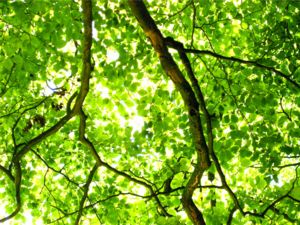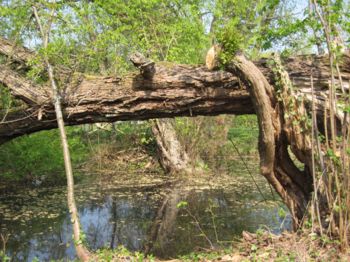Tree (plant)
In botany, a tree is a large, perennial, woody plant. Though there is no set definition regarding minimum size, the term generally applies to plants at least 6 m (20 ft) high at maturity and, more importantly, having secondary branches supported on a single main stem or trunk with clear apical dominance (see shrub for comparison). Compared with most other plant forms, trees are long-lived. A few species of trees grow to 100 m tall, and some can live for several thousand years.
Trees are important components of the natural landscape and significant elements in landscaping and agriculture, supplying orchard crops (such as apples). They are also important for a healthy environment, in that they produce oxygen, their presence may slow flood waters, prevent soil erosion, absorb carbon dioxide, provide habitat and nourishment to birds, insects, and wild animals, and make the world more beautiful.
Trees play a role in many of the world's mythologies (see trees in mythology).
Classification
A tree is a plant form and trees occur in many different orders and families of plants. Trees thus show a wide variety of growth form, leaf type and shape, bark characteristics, reproductive structures, etc.
The earliest trees were tree ferns and horsetails, which grew in vast forests in the Carboniferous Period; tree ferns still survive, but the only surviving horsetails are not of tree form. Later, in the Triassic Period, conifers, ginkgos, cycads and other gymnosperms appeared, and subsequently flowering plants in the Cretaceous Period. Most species of trees today are flowering plants and conifers. The listing below gives examples of many well-known trees and how they are typically classified.
A small group of trees growing together is called a grove or copse, and a landscape covered by a dense growth of trees is called a forest. Several biotopes are defined largely by the trees that inhabit them; examples are rainforest and taiga (see ecozones). A landscape of trees scattered or spaced across grassland (usually grazed or burned over periodically) is called a savanna.
Morphology
The basic parts of a tree are the roots, trunk(s), branches, twigs and leaves. Tree stems consist mainly of support and transport tissues (xylem and phloem). Wood consists of xylem cells, and bark is made of phloem and other tissues external to the vascular cambium.
Trees may be broadly grouped into exogenous and endogenous trees according to the way in which their stem diameter increases. Exogenous trees, which comprise the great majority of modern trees (all conifers, and all broadleaf trees), grow by the addition of new wood outwards, immediately under the bark. Endogenous trees, mainly in the monocotyledons (e.g. palms), grow by addition of new material inwards.
As an exogenous tree grows, it creates growth rings. In temperate climates, these are commonly visible due to changes in the rate of growth with temperature variation over an annual cycle. These rings can be counted to determine the age of the tree, and used to date cores or even wood taken from trees in the past; this practice is known as the science of dendrochronology. In some tropical regions with constant year-round climate, growth is continuous and distinct rings are not formed, so age determination is impossible. Age determination is also impossible in endogenous trees.
The roots of a tree are generally embedded in earth, providing anchorage for the above-ground biomass and absorbing water and nutrients from the soil. It should be noted, however, that while ground nutrients are essential to a tree's growth the majority of its biomass comes from carbon dioxide absorbed from the atmosphere (see photosynthesis). Above ground, the trunk gives height to the leaf-bearing branches, aiding in competition with other plant species for sunlight. In many trees, the arrangement of the branches optimizes exposure of the leaves to sunlight.
Not all trees have all the plant organs or parts mentioned above. For example, most palm trees are not branched, the saguaro cactus of North America has no functional leaves, tree ferns do not produce bark, etc. Based on their general shape and size, all of these are nonetheless generally regarded as trees. Indeed, sometimes size is the more important consideration. A plant form that is similar to a tree, but generally having smaller, multiple trunks and/or branches that arise near the ground, is called a shrub. However, no sharp differentiation between shrubs and trees is possible. Given their small size, bonsai plants would not technically be 'trees', but one should not confuse reference to the form of a species with the size or shape of individual specimens. A spruce seedling does not fit the definition of a tree, but all spruces are trees. Bamboos by contrast, do show most of the characteristics of trees, yet are rarely called trees.
Life stages
The life cycles of trees, especially conifers, are divided into the following stages in forestry for survey and documentation purposes, though the boundaries between stages vary among foresters:
- Seed
- Seedling: the above-ground part of the embryo that sprouts from the seed
- Sapling: After the seedling reaches 1 m tall, and until it reaches 7 cm in stem diameter
- Pole: young trees from 7–30 cm diameter
- Mature tree: over 30 cm diameter, reproductive years begin
- Old tree: dominate old growth forest; height growth slows greatly, with majority of productivity in seed production
- Overmature: dieback and decay become common
- Snag: standing dead wood
- Log/debris: fallen dead wood
Tree diameters are measured at height of between 1.3–1.5 m above the highest point on the ground at its base (known as "breast height"). The 7 cm diameter definition is economically based, from the smallest saleable stem size (for paper production, etc), and the 30 cm diameter is the smallest base diameter for sawlogs. Each stage may be uniquely perceptive to different pathogens and suitable for especially adapted arboreal animals.


